383 miles. Six Days, No engine. No self-steering. Two calls from the Coastguard: “Do you require assistance?”
No.
I came to Galway because it wasn’t Killybegs. I had been in Killybegs for a month for what we might call the “Major Works”, and there really isn’t much to the place apart from the boatyard.
Galway, on the other hand, is a favourite – full of music and gastro pubs. The fish and chip shop serves oysters…
Also, it was as far as I got in an attempt to sail to Cobh in County Cork to meet with the family for a weekend’s walking. The autopilot had packed up again – this time terminally. I ordered a new tiller drive and went to Cobh on the bus.
The other reason for being in Galway was that the engine was overheating (again). This has been the bane of my life for the last five years – you may remember the trouble in the Isle of Man. Now I couldn’t run it for even one minute. They had to tow me in.
But, yes, we had a lovely time rambling over the southeast coast, getting just a little bit lost and finding wonderful restaurants in unexpected places. Now it was time to move on. Pat Ryan Engineering had tried for six days to send someone to look at my engine, but clearly it just wasn’t going to happen, no matter how much Pat promised he would “absolutely, most definitely” try to get someone to me tomorrow. I went to the Harbour office to pay the bill. The lock gate would be open until 1541.
I’d love to know what I was doing at 1541. Certainly, I was very busy because, still with no engine, I proposed to put the little Remigo electric outboard on its new bracket on the back and go whizzing out with that. I checked the time. High water was 1400, and the one thing I know about Galway is that the lock opens for two hours each side of High Water – in other words, until 1600.
Except on this particular day, it was going to be 1541, wasn’t it? They’d told me so.
Sure enough, the little Remigo pulled me backwards out of the berth, spun me round (once I worked out that I couldn’t rely on the flow of water over the boat’s rudder and instead had to lean over the back and steer the motor itself.)
Eventually, we got out and into the main channel, where you can see out into the bay. Except, this time the view was blocked by the lock gates – the closed lock gates.
I tried again at 0200. I’d got the hang of the Remigo by this time, and we went humming down the channel to the (open) lock at 1.9kts (and only at half power).
Then it stopped. Since I had no idea why, I did the only thing I could think of and unfurled the headsail. It didn’t help. There wasn’t a breath of wind, but it did give me the time to realise I’d been fiddling absent-mindedly with the outboard’s remote control and turned it off.
Once we got out, the new drive unit for the autopilot packed up.
Actually, that’s not entirely fair. As the display pointed out, the real problem was “low power”. I’ve been chasing this for months and spent a fortune on electronics engineers, but that didn’t stop me having to rely on the rather Heath-Robinson sheet-to-tiller arrangement that’s been steering the boat since The Scillies.
As it happens, I’m rather pleased with it: I’ve discovered that it also works downwind (as it’s supposed to, according to the book). It’s just that you’re better off without the headsail, downwind. This might explain why, as I write this, we’re doing only 1.8kts and it will take 26 hours to get to the waypoint off the Dingle peninsular. I sent an email to the Ocean Cruising Club saying I wasn’t going to make dinner on Saturday night.
Day One
Off the Dingle Peninsular.
It really is remarkable how far you can go if you don’t stop and have all the time in the world. It appears I have now sailed 65 miles. Admittedly, that is in thirty-three hours, but I am now down at the bottom with only 13 miles to go to the waypoint off Tearaght Island.
It has to be said that the apparent wind is 0.0kts. I say “apparent” because the plotter shows us doing 0.71kts in the right direction. So, we will get there.
It’s a shame because I could have left on Monday night when the wind was still blowing. But if I had done that, I would have missed what I understood to be Pat Ryan’s “absolutely cast-iron promise” of an engineer coming out on Tuesday.
Now I’ve had a chance to think about this a bit more logically and realise that I’ve left messages with half a dozen marine diesel specialists in both Falmouth and Torquay, and only one has got back to me (and they’re in Dartmouth). Instead, I rang Rab, the friendly – but equally unreliable – Scotsman in the Isle of Man and had a frank discussion.
Years ago, I had been told that trying to get the heat exchanger off the engine would probably damage both beyond repair. Also, I looked up the previous owners’ maintenance log and found that the Nanni’s first service was back in May 2005. So, it is a full 20 years old. Also, don’t forget the boat has been in commission year-round for the past nine. Maybe this is just anno domini. Anyway, I’ve now ordered a new Vetus 27HP to be installed along with the Hydrovane self-steering and Watt&Sea hydrogenator.
This has all made a big dent in the savings. Another thing: I can’t stay on the boat while the work is done. This means I shall have to find a cheap B&B – but it seems there’s no such thing on Guernsey. It’s a hotel at £160 a night or a tent (I did investigate campsites, but didn’t find one. Just as well, I hate camping, and by the time I bought enough stuff to make myself comfortable, I could probably stay in a hotel.)
And, I could get on and finish the second edit of The Voyage #3 (these things should be done quickly – ideally in one, intensive session. But it’s never happened…)
Meanwhile, the speed has dropped again. For long periods, the plotter records “0.0kts”. These are just the conditions I hoped would test the Remigo, but it’s cloudy and I don’t want to use electricity for charging – not if it means I won’t be able to make tea.
*
Well, here’s a fine kettle of fish. It’s half past one in the morning and I’m totally becalmed 2.7 miles from an exposed rock called Great Foze Rock (I remembered that because I’ve just entered it as a waypoint on the plotter – not that I ever intend to go there) or Inishtearaght Island, which 1.8 miles away and big enough to have a lighthouse. This is good, because when I woke up to the half-hour alarm, I was 1.5 miles from Great Foze Rock.
Four hours later, I was still floating about in more or less the same place with no hope of any real wind for at least another 18 hours. The predicament puts me in mind of a competitor in the Jester Challenge who was in a similar situation with engine trouble near the Scillies. Of course, they have much stronger tides there. He ended up calling out the Lifeboat.
I won’t need to do that. I still have almost a full charge in the Remigo – and, of course, in extremis, I could run the engine until it explodes. It’s going to be thrown away anyway.
In the meantime, I have tacked and tacked again. This may not sound like much, but remember, I have the storm jib sheet-to-tiller self-steering set up, which means that the headsail has to be furled to get round it, then the jib itself has to be switched from one bow cleat to the other. Next, in the cockpit, I have to pull the sheet out of two blocks (one single and one double) and re-reeve it on the other side – and finally, I mustn’t forget to set up the shock cord to the tiller as a counterweight.
I say “finally”, but it is not final at all: the next ten minutes are filled with tweaking to find the exact opposing tensions on the sheet and the shock cord to steer a course.
Admittedly, I have now added a second double block on the starboard side and another single on the tiller so that I don’t have to pull one sheet out and feed in the other every time (you can never have enough blocks).
In the end, the wind was so light that I ended up hand steering – and the tide still swept us ever closer to the rocks.
When the distance to the lighthouse was down to 1.2 miles, I started the engine. It ran for just over a minute before the temperature got to 62°C, and I turned it off. At least now I know its limits. By 4.30, I had given up any pretence of trying to make headway and ran off to the northwest – at least I was getting away from the lighthouse. As I write this, the clearance is 2.9 miles thanks to the tide (I just looked at the windspeed indicator and it said “0.0kts”.)
When would the tide would turn? I looked for the answer in my current copy of Reeds (current in my case meaning 2021). It told me “three-and-a-half hours ago”. Where did that come from? Anyway, I was just making my third honey sandwich – the apricot jam ran out with the first – when I heard the wind charger starting up, and now we’re 3.3 miles away from the lighthouse, doing 3.1 knots – not entirely in the right direction, but at least away from the damned lighthouse. We’re even heeling. I might be able to go back to bed.
Day Two
Off Valentia
A much better day. At one point, 17 knots of wind, and we’ve been storming along in the right direction. The “string-and-a-prayer” self-steering needs at least ten knots. I got so fed up with it that I tried the autopilot again, just in case all it needed was a rest. As usual, it worked for a minute or two and then announced “low power” and went to sleep.
I didn’t immediately disconnect it because the boat seemed to be managing all right. Then I realised it had stopped with the helm adjusted perfectly so that we just kept sailing along bang on course, so I carried on like that for four hours, eventually substituting shock cord lashings because I thought there might be a strain on the drive unit. Why I never tried this before, I have no idea. It’s much simpler. I left the storm jib lying all over the foredeck. It might fall in the water, but it couldn’t get away. In fact, it blew itself up against the spinnaker boom on the lee side and lay there like a Labrador with its back to a radiator.
I don’t know what I’m going to do about this. Writing to Boatworks in Guernsey about the new engine, I added a request for an electronics engineer to my email, but what they’re going to do, I have no idea – after all, it works when you test the voltages. It’s only when you use it for a while that it packs up.
When in doubt, I ring Dave Jones, the one-man MarineTech company in Wales who installed the thing – and much else, besides. He seems to think I’m a bit of a hero, so he’s always up for a phone call. I asked him if he had installed a fuse anywhere that might be a weak connection. He didn’t think so, but chatting about it, we decided the switch panel is probably as old as the boat, and so, very likely a weak point. Certainly, it would be worth replacing those two circuit breakers. Better still, a new panel altogether – better than that even, a total re-wire of the boat. I asked how much he would quote if he was doing it: £3,000…
By pure chance, I enlarged the Navionics screen of the route to The Bull off Dursey Island and was surprised to see The Skelligs in the way. I hadn’t noticed them at all, which would never do because (1) they are hard and rocky and (2) they occupy a soft spot in my heart because last time I was here, I took two pictures a minute apart at sunset and they made perfect covers for The Good Stuff Book One and The Good Stuff Book Two.
I was going to give them a similarly wide berth this time, but it would have meant tacking, and that is a bit of a palaver with the storm jib to move and whatnot, so instead, I went between them – it’s not much more than half a mile, and a perfect opportunity to play with my new Steiner binoculars (a present to myself before Rab told me I needed a new engine).
Great Skellig – or Skellig Michael – is home to an early Christian monastery, and a rather odd one at that. While monks tend to go for a hard life, those who headed for the Skelligs liked their solitude on steroids. Their tiny stone hovels are there to see today. In fact, they’re so extraordinary that they starred in the Star Wars films, The Force Awakens and The Last Jedi. You can take a Star Wars tour, landing next to the little white hut in the picture and climbing up those precipitous stone steps.
Anyway, it’s cocktail hour. We’re doing five knots in the right direction over a smooth sea, and Tamsin brought a bottle of Bombay Sapphire when she flew in to Cork. Of course, being a liquid, she couldn’t take the rest of it back with her, so I’ve got half a bottle of gin aboard.
Gin is unusual aboard Samsara, because I can’t make ice, and you mustn’t drink gin without ice (all right, if you were in the Navy in the 1950s, you would have ordered pink gin from the mess steward). Anyway, I’ve got a pack of those little cans of tonic and the fridge makes them passably cold – the slice of lime too. I think I might just have one with The Adventures of Tom Sawyer. I bought James, the Booker prize-winner which is about an escaped slave who buddies up with Huckleberry Finn, so then thought it made sense to do some preparatory reading. Maybe this will be one Booker prize-winner I actually enjoy.
Day 3
Well, we’re getting there. I woke up to find we had lost the Starlink signal as we set off on the long haul across the Celtic Sea to the Scillies. Actually, it’s only about 150 miles, but a long haul because I can expect calms or light headwinds from tomorrow onwards. Meanwhile, we’re doing a steady three knots over a calm sea, heading to the west of the course so as to be on the right side of the wind shift when it comes (don’t you just love the Windy app?)
Today is Saturday, and the Ocean Cruising Club dinner starts with a welcome drink on the terrace overlooking Falmouth Harbour at seven o’clock. Which I will miss. It’s a damn shame. But on closer inspection, it wasn’t just the engineer not turning up, or whether the lock gate opened two hours each side of high water or one hour nineteen minutes. There was also a small miscalculation in measuring the distance between Galway and Falmouth. Apparently it’s 383 miles, not 300…
So, all of this meant that I had allowed myself only two-and-a-half days to cover all that distance down the west coast of Ireland, across the Celtic Sea, from the Scillies to Land’s End and finally round The Lizard and up to Falmouth. Even at my record of 140 miles over 24 hours in the Gulf Stream, I couldn’t have done it. Anne, the OCC Port Officer, is going to see if she can get me a refund – at least on my half bottle of the wine allowance. It galls me that I’ll miss the port.
One of the last messages to come in before the signal died was Tamsin asking if I had ever been to Zell am See. She’s planning next year’s skiing holiday, and everyone says they’d like to go earlier than Easter, which we’ve been tied to by school holidays, even after all the children left school because Tamsin was working at East Suffolk College. Now she has a new job, she can take her holiday whenever she likes.
But I won’t be back from my South Atlantic Circuit by mid-March – not if Hugo comes to join me in the Canaries, and he can’t do that until sometime in November.
And now the sun’s come out. We should be making some decent electricity. I didn’t mention that on the first two evenings of this trip, I felt obliged to have a cold dinner while trying to preserve the batteries above 50%. I don’t really need to since converting to Lithium, but I don’t want to risk running them flat and losing the lights and the AIS.
By the time I get to Guernsey, I will have completed 1,100 miles without self-steering. By that I mean without a wind vane self-steering gear or an autopilot. I like to think that makes me something of an expert.
Of course, I will tip my hat to Andrew Evans who taught me how to do it, and give a plug to his book Thoughts, Tips, Techniques & Tactics for Singlehanded Sailing (Third Edition). The truth is that once you know the basics, you’re only at base camp. The rest is on-the-job learning – and what you learn is very likely only applicable to the boat you learn it on.
I can sit on the lee berth and write this undisturbed because, I have finally got Samsara sailing herself.
The trouble is that there are so many factors that go to make up the perfect balance. For instance, now she doesn’t like it with the jib tacked down to the starboard bow cleat – but apparently it’s all right tied to the tensioning nut on the anchor windlass. Although this is closer to the centre line, it is also a bit further forward.
Here are some other adjustments that make all the difference.
- The height of the tack above the deck.
- Whether the sheet is led inside or outside the spinnaker pole.
- Tensioning of the headsail.
- Tensioning of the mainsail.
- Position of the car on the mainsheet track
- One or two shock cords pulling the tiller to leeward.
- Tension of the shock cords.
- Tension of the sheet on the tiller (honestly, two clicks of the winch can mean a difference of 10°.)
- There is also the option of setting the storm jib on a spinnaker pole ahead of the forestay. This involves a whole different set of adjustments all of its own – and, I would disagree with Mr Evans and say that on Samsara at least, it’s best to dispense with the headsail when running – it wouldn’t do much good anyway, being blanketed by the main.
- And finally, everything depends on whether or not I’ve just made a cup of tea and settled down with Tom Sawyer – because that is sure to upset the apple cart.
Apparently, somebody called Tony Skidmore got it to work and sailed 17,000 miles in a 24-footer. It’s not a record I plan to challenge.
My father could be a bit of a show-off at times. I remember one occasion: We were all sitting around the table and Father undertook to shake the tomato sauce – you will remember that in those days it came in a conical glass bottle and, when less than half full, had to be shaken down to the neck before the sauce would come out. Father shook with a flourish. Above his head. With vigour.
This would have been fine. We would all have been impressed – if the top had been screwed on securely. It wasn’t – and the result was tomato sauce all over the ceiling, all over the walls, the carpet…
All over Father, come to that.
And us.
I have just managed something like the same effect, although on a smaller scale, with the hoi sin sauce all over the chart table, the Kindle, me…
Day 4
The Celtic Sea
I have hard-boiled the last two eggs. This was an admission of failure. I set out with five, which I thought would be ample – in fact, I only boiled three of them for the fridge, reasoning that I might arrive in Falmouth at night and need them fried with Tomatoes, Marmite and toast for breakfast. In fact, I shall count myself fortunate if I don’t have at least one egg-less breakfast before I get there.
If you’re interested, I eat them with a bottle of Worcestershire sauce in one hand, adding more with every bite. The secret is to aim it at the yolk where it soaks in. If you hit the white, it just runs off all over your fingers. Did you know that in Central America, they try to copy it and call it Salsa Inglesa? It’s not the same.
I definitely need a Watt&Sea. We’ve been sailing into 15kts apparent wind with the wind charger whirring away all night, but when I got up, the batteries were still only at 42%. Now that I’ve boiled the last eggs and made a cup of tea, they’re down to 38%. I’ve angled the two solar panels on the guardrails – the “wings” – to face the sun, but it still may be cold dinner tonight. Certainly, it will be a beer instead of a cup of tea for lunch.
And now I’m wishing I had switched Starlink to “Global” mode. It’s crazy. It would have made sense if I decided I didn’t need it and switched it to “Pause”. Instead, I’m still paying for unlimited data within ten miles of land, when after all this time, I’m still 50 miles from land.
No sooner had I written that, than the phone went “ping” and, for a magic moment, I thought I had a connection, but it was only the calendar reminding me it’s time for the OCC raft-up – and I’m 80 miles away (or 200 with the wind as it is.)
Also, it would be really handy to know whether I should tack. The last forecast I had showed calms all over The Scillies by now, but I’m still doing very nicely into 12kts apparent.
Very nicely, but in the wrong direction.
Out of nowhere, a big French yacht. I wouldn’t have known he was there but for a call on the VHF. Before I answered, I checked the plotter, and there he was, just crossing my stern, I didn’t even register the name. Why hadn’t I heard an alarm? I didn’t even have any music playing. Still, there was nothing for it but to answer: “Station calling Samsara. Say again.”
In good but heavily-accented English, he said he had crossed my stern two minutes ago and noticed there was something wrong with my staysail.
I took great delight in telling him: “My windvane is in Amsterdam and my autopilot is broken, so I am steering with my storm jib sheet lashed to the tiller. It works very well, but it looks a little odd…”
I could tell he was impressed. It was just as well I was on starboard tack and had the right of way. Otherwise, he might think I hadn’t been looking…
There is hope: It’s eight o’clock on Sunday evening, and I was planning on getting to the waypoint to tack round to the west of the Scillies before starting dinner. Now I’m not so sure. The wind has veered a little. Maybe I should beat down the inshore passage. It’s only 12 miles and easy if you get the tide with you… which I might manage. If not, it just takes longer, but I could steer for that long (didn’t I manage five hours or something in that gale of the Northwest coast of Ireland?)
The great advantage of this tactic is that it gets me into mobile phone range by about six o’clock tomorrow morning – which means a forecast (OK, so it’s a bit late for a forecast. By then, I’ll be committed to the inshore passage).
Also, it means I can start dinner now.
Day 5
20 miles north of St Ives
If we keep going, we’ll end up in Bristol. Surely I must be able to tack for the inshore passage round Land’s End by now, but I kept waiting for daylight and of course, it’s the end of August, and dawn is coming up later and later. So, when I did finally put about, we could lay the course easily without me having to steer. Indeed, the 60° off the wind which is what the sheet-and-a-prayer system seems to prefer, actually puts us ashore in St Ives Bay. That might be the tide which turns with us in two hours and might just sweep us all the way down to Gwennap Head.
Well, that didn’t end well. In fact, over the next 36 hours, so much was happening that I didn’t get to write a word about it as it was happening. When I finally arrived at the top of the inshore channel, everything seemed to be going swimmingly – but of course, that was only because I had the tide with me. Once it was going the other way at a couple of knots, it was a different story. The Navionics track reminded me of that awful beat back to Mindelo in The Voyage #2. But then I was under threat of arrest and incarceration in a Cape Verdean prison.
This time, I had the option of stopping – and that seemed like a brilliant idea. I could anchor somewhere and wait for the next favourable tide (about 2100, it seemed). I could have dinner… a bit of a kip without worrying about the boat tacking herself. Whitesand Bay looked ideal. But suddenly the good progress came to an end and I fetched up in some place called The Crown, a grim indentation of sheer cliffs with strange ancient buildings on the top – towers and lookout posts, long since deserted… or so I thought…
I heaved the anchor over. I had planned in 20 metres. In fact, when I checked, it was 23. So, I had 90 metres of chain down there. It’s amazing that the sound of an anchor chain grinding its way across rock can be transmitted to the surface loudly enough to drown out Dr Hook while the skipper is frying onions.
It was a morose meal. For one thing, I wasn’t frying onions, I was just overheating the other saucepan because I had got my hobs mixed up (I do this all the time since converting to electricity and getting a twin hob induction cooker.)
Then I tried to get some sleep while aware that the anchor was dragging very slowly over the rock.
The trouble with rock is that not only does it not, some of the time, allow the anchor to get a hold, but there is always the chance that the anchor might get a very good hold like, for instance, being stuck under a rock where no amount of pulling will get it free. What was I to do then? Cut free the bitter end and buy a new anchor and chain (and the very expensive, top-top-of-the-range swivel)? Buoy it with a fender and offer a reward to some enterprising fisherman with a hydraulic winch?
Meanwhile, there was nothing I could do and, at about half past eight, I gave up on the idea of sleep and prepared to set off again. I turned off the anchor light and switched to the masthead tricolour to show I was “under way”. Even if I wasn’t yet.
Clearly, I wasn’t. About ten metres of chain came back aboard (agonisingly slowly) and then stopped.
Of course: I had no engine, nothing to put any amps into the lead/acid engine start/windlass battery while I was drawing 1000watts grinding in the chain. To give me credit (I need all the credit I can get), I had thought of this and had the little 7-amp charger plugged in, drawing from the Lithium bank. Still, you can’t expect a 7amp charger to keep up with 1000W… all right, I never did understand Ohm’s law…
So, there I was with 80-metres of chain out – not forgetting the20kg anchor on the end of it – around 130kg all told…
OK, so I tried pulling it by hand.
It nearly pulled me in, and I lost a couple of metres during the learning curve.
What you do in this situation is use the powerful cockpit sheet winches. I tied a long 10mm line to the chain hook, led it through the staysail fairlead and onto the winch.
And started grinding.
By the time I was out of breath, the hook was back at the fairlead – half the length of the boat… about five metres…
Here is the routine for pulling up an anchor using a sheet winch.
- Once the hook is back at the fairlead, go up to the foredeck and get a rolling hitch onto the chain and take the strain on one of the foredeck cleats.
- Then you can go back to the cockpit and cast off the winch.
- Next, go back to the foredeck and feed half the chain on deck down into the chain locker (it doesn’t want to cooperate in this, and a good bit of jiggling ensues.)
- Pull the chain hook forward to attach it again as far forward as possible.
- Take up the slack on the sheet winch
- Cast off the rolling hitch.
- You have now regained your breath and are able to start grinding again.
Congratulations, you have just pulled up five metres of chain. Only 75 to go…
I got into a rhythm after a while – added little tweaks, like leaving enough chain on deck to get dragged back to the fairlead. I thought I was doing quite well. Then someone shone a very bright light at me.
It came from the top of the cliffs, presumably from one of those ancient structures that seemed to be not so deserted after all. Obviously, somebody couldn’t understand why a vessel showing running lights wasn’t moving. I nipped down and switched them off. Turned on the anchor light instead (after all, I was still very clearly anchored). The light went out. I returned to my routine.
Then I noticed the phone ringing. I well remember the first time I heard a phone ring on a boat, and how peculiar it seemed. When I started sailing, people went off on boats to get away from the telephone – doctors in particular. It still seems an intrusion. I ignored it.
I ignored it when it rang again. Eventually, I looked at the screen. This was Tamsin calling. She was used to me not picking up if I was busy. I would see she had called. I would ring back – but this level of persistence spoke of some urgency. Immediately, I thought of the children and the kind of disasters parents imagine at times like this. I stabbed the green button: “Look, I’m a bit busy. Can I call you back?”
“This is urgent,” said Tamsin. She had received a call from the Coastguard. Did she know where I was? Did I need assistance? Would I call 999 and report my emergency…
I called 999, but they were only interested in Fire, Police or Ambulance. They didn’t appear to have heard of the Coastguard. I tried VHF and got through immediately. I assured Falmouth Coastguard that I did not need assistance: “I’ve got no engine, and so I have no power to the windlass, and I’m having to get the anchor up by hand. Also, being singlehanded and with no self-steering, it’s proving a fairly difficult passage, but I should be underway again soon.’
And yes, I would be sure to inform them when I was… and, when I arrived in Falmouth. Thank you. Goodnight.
It still took me two-and-three-quarter hours of traipsing back and forth to the foredeck, grinding on the winch, feeding the chain down through the hole before the 15metre marker crawled over the bow roller.
Interestingly, the depth recorder was showing 23metres at the time. How do you explain that?
One way and another, I must be nearly there. Maybe the battery had recovered a bit. They do that if you leave them. I was just about to try the windlass again, when I remembered the trip switch. If the motor finds it just too much like hard work and things are in danger of overheating, the trip switch with call a halt to proceedings. Sure enough, that was the problem. I turned it back on and the last 15 metres came aboard in a rush – and with the anchor on the end, I was pleased to see. Not stuck under a rock.
Now why didn’t I think of that two and three quarter hours earlier. Put it down to Not Thinking. But then, if you’ve read my autobiography Faster, Louder, Riskier, Sexier, you’ll know all about that.
Of course, the tide was turning again. You can’t have everything.
Day 6
It took forever to get round Land’s End and across Mount’s Bay, and then came The Mother of All tangles. By this time, I had lost patience with the “String-and-a-Prayer” system and had reverted to two shock cord lashings on the tiller, pulling opposite ways (which often led to pointing in opposite ways), but I had left the storm jib up, flapping ineffectually.
For sheets, I was using the long, long 8mm lines that normally sheet the Super Zero. They are, in fact 17 metres long, almost twice the length of the boat, so I reasoned they were hardly likely to pull all their length out of the four blocks on each side.
Which is why I did not put stopper knots on the ends.
Which is why, when they did pull out and went flying away in a squall just past the Lizard, they tied themselves into the biggest knot I have ever seen. Really, I wish I had taken a picture of it. If you imagine two 17 metres lines convulsed into a haphazard bundle that would fit conveniently inside the galley gash bucket…
No, that doesn’t do it: Try thinking of what happens when the cat gets into Auntie Nelly’s knitting basket. Now translate that into Liros 8mm polyester braid…
Well, it was a big tangle. Of course, what I should have done was drop the storm jib on top of it, bundle the whole lot down the forehatch and worry about it when I got in. I could have taken a picture of it, too.
But no, that would be too sensible (see the book recommendation above). Instead, I settled down on the foredeck to untangle it straight away. It’s easy enough. All you need are two ends (or in this case, four), a modicum of patience – and all the time in the world. It took me 40 minutes, which I thought wasn’t bad.
Unfortunately, during this 40 minutes, the tide turned again – and began dragging me back to the west… right into the race off the Lizard.
I was vaguely aware of the white water, and how it was getting closer. But it didn’t look that bad and I hadn’t got wet yet…
It was when I was emerging from the cabin, fully suited-up in my brand new Irish Guy Cotten oilskins that I heard the Coastguard calling me once more.
For Heaven’s sake, what now?
A member of the public, a fellow yachtsman, was sitting in a café on the cliffs and had been watching me for some time. He was concerned, so he had called the Coastguard – and, of course, the Coastguard are duty-bound to investigate all reports, no matter that they be made over cream tea…
I assured the man, once again, that I did not need assistance – adding that I would appreciate if he would pass on my thanks to the concerned fellow-yachtsman.
And so, finally, eventually, I anchored under sail in Falmouth Harbour off Trefussis Point where there’s no danger of hitting anyone else since the Harbour Master started charging for anchoring absolutely anywhere in his jurisdiction, so you might as well go into the Haven anchorage and leave your dinghy on the dock instead of climbing up ladders – and then coming back to find the tide’s gone out and you’ve got a walk through the mud.
So, I got everything stowed away, had a cup of tea and popped the Remigo electric outboard onto the stern. It had got us out of Galway – but that was in a flat calm. How would it fare with a 10kt headwind?
Just fine, as it turned out. We whirred the half-mile over to the other side at a steady two knots on half power, turned round (on a sixpence again, thanks to the ability to lean over the back and steer it). Just remember that while the Remigo will keep you going once you have some momentum, it doesn’t have much in the way of stopping power. Still, no harm done and dinner at Balti Currie (it’s a tradition).

Galway nightlife

..and by day
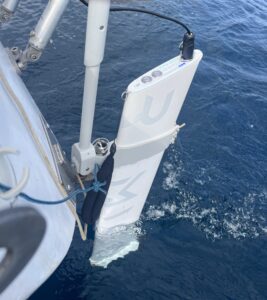
The RemigoOne electric outboard – moving a 5,500 kg Rival 32 at 1.9kts (on half-power!)

The sheet-to-tiller (string-and-a-prayer)self-steering
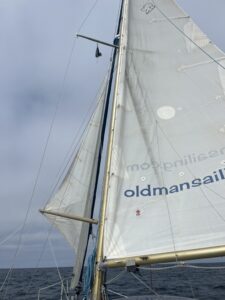
…and in downwind mode.
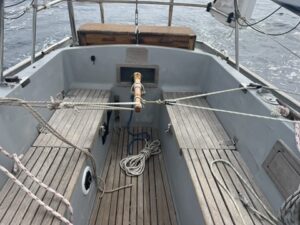
…meanwhile, in the cockpit.

Or steering by shock cord…

Great Skellig
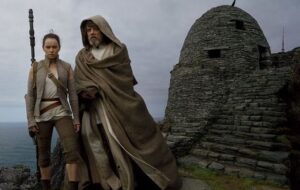
..star of Star Wars.










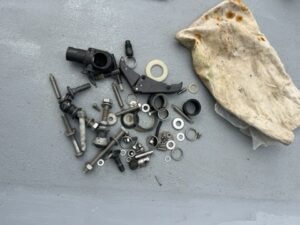

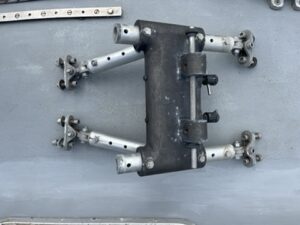


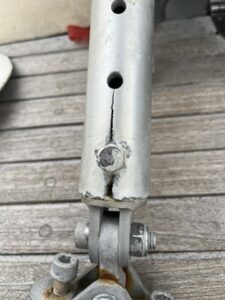









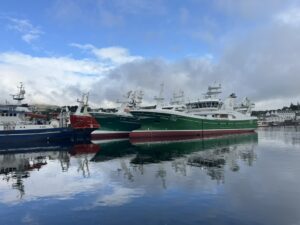


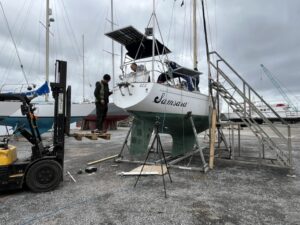




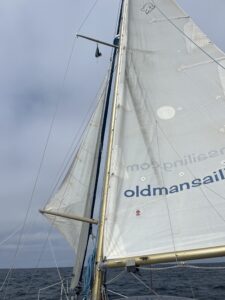




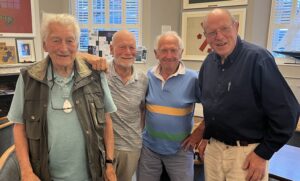

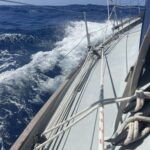
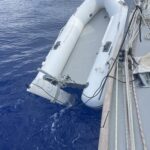
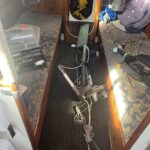
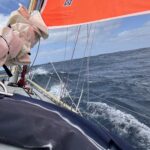
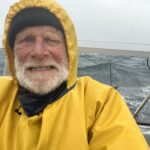

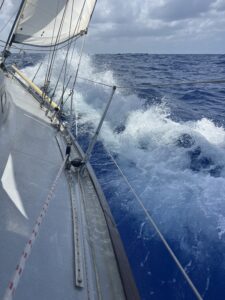
Surprised that it took so long to diagnose. Regular removal and cleaning of the exhaust elbow, yearly or after 250 hours, and replacement after two years is recommended by all (most?) marine diesel engines manufacturers! I think that this last is a bit extreme, particularly as they can be quite expensive on newer engines, but definitely remove and inspect every two years. Apart from anything else, a blockage here can cause extensive engine damage, even if not completely blocked.
I had this problem with a generator on my Cheoy Lee, it was easy to find though as the exhaust broke at the elbow, completely bunged up which is surprising as diesel generators run at fixed speeds, still it was 28 years old.
Alternators, do check the output is correct if you are using AGM or Lithium batteries, charging regimes are quite different from Lead acid. Easy to get the alternator output changed.
Regards,
Leslie
It’s OK, the alternator charges the AGM engine-start battery and the new one is the correct model for my engine.
Yanmar recommend running at high revs for a few minutes for every 30 minutes of low revs, idle or tick over, and revving hard in neutral 4 or 5 times before cutting the engine at the end of a cruise.
I understand that this is intended to burn off coke deposits in the exhaust elbow, where cooling sea water is mixed with exhaust gases.
Engines and mechanics, that combination that the devil refuses to accept.
The engine of my boat, a Volvo MD2040, also overheated. After many mechanics, the heat exchanger had been replaced, as well as the saltwater pump, the saltwater filter, all the water pipes, the exhaust manifold and the thermostat. Result: it continued to overheat.
It was dismantled, completely overhauled and repainted. €8,000 later, I had a beautiful engine that overheated just like before. In desperation, I started asking for quotes for a new engine.
By chance, I had the Saildrive seal replaced, which, at 22 years old, had long since passed its expiry date. And voilà. The problem was in the Saildrive (the cooling water passes through the interior), whose interior was clogged with the remains of marine animal shells.
If you are dealing with alternators, consult these people. Cheap and the best information I have ever found. https://www.morganscloud.com
Many Volvo Saildrive owners fit a new skin-fitting, seacock and water strainer for seawater cooling, exactly because of this problem.
VERY old joke: “I want to complain about this bill for fixing my car. I hear you just tapped the side of the carburetor with a hammer. How can you possible justify £20 +VAT?”
“Very sorry sir. Let me correct that for you”
“tapping the carburetor with a hammer £ 0.50”
“knowing what to tap and where to tap it £19.50”
“plus VAT”